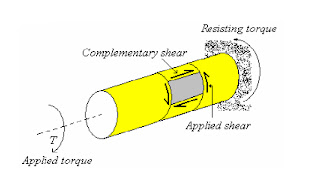7.1 BASIC CONCEPTS
Column. A bar or a member of a structure inclined at 90° to the horizontal and carrying an axial compressive load is called a column.
Slenderness ratio. The ratio of the equivalent length of the column to the least radius of gyration is called the slenderness ratio.
Buckling load. The minimum axial load at which the column tends to have lateral
displacement & buckle is called the buckling, crippling or critical load.
Equivalent length. It is the length of the column which gives the same bthkhflg otd , as given by a both ends hinged column.
Short Column. A column for which the slenderness ratio is less thani iled a short column.
Medium Column. A column for which the slenderness ratio lies between 32 and 120 is called a medium column.
Long Column. A column for which the slenderness ratiQ is more than 120 called a long column.
Safe load. It is the load under which the column will not buckle.
7.2 EULER’S THEORY OF COLUMNS
The following assumptions are made in this theory:
1. The column is initially straight and the applied load is truely axial.
2. The material of the column is homogeneous, linear and isotropic.
3. The length of the column is very large as compared to the cross-sectional dimensions of the column.
4. The cross-section of the column is uniform throughout.
5. The shortening of the column due to axial compression is negligible.
6. The self weight of the column is neglected.
7. The ends of the column are frictionless.
There can be three conditions at the end of the column.
2. Pinned end. For such an end, y =0
3. Free end, The column is neither fixed in position nor in direction.
Depending upon the end conditions, there are four types of columns.
• Both ends hinged
• Both ends fixed
• One end fixed and other end hinged
• One end fixed and other end free.
7.2.1 Column hinged at Both Ends
Consider a column having both ends hinged and carrying an axial compressive load P as shown in Fig. 7.1. Taking origin at A, the bending moment at a distance x is:
7.2.2 Column fixed at both ends
Consider the column fixed at both ends as shown in Fig. 7.2 Let MA id M8 be the fixing moments at the ends. At a distance x from A,
7.2.3 Column fixed at one end and hinged at the other
Consider a column hinged at end A and fixed at B as shown in Fig. 7.3. There will be a tbckig m om entM B and a horizontal force RA will have to be applied to A to keep the column in equilibrium. At a distance x from A,
7.2.4 Column fixed at one end and free at the other
Consider a column as shown in Fig. 7.4. Let the horizontal deflection of end A be and fixing moment at end B be MB.
7.2.5 Limitations of Euler’s Theory
1. The Euler’s theory is applicable to columns which are initially exactly straight and the load is truly axial. However, there is always some crookedness in the column and the load may not be exactly axial.
3. This theory does not take into account the axial compressive stress.
7.3 RANKINE’S FORMULA
This formula takes into account the effect of direct compressive stress. Rankine proposed that crippling load,
7.4 I.S. FORMULAE
1. Straight line formula
Example 7.1 A hollow steel column having both ends fixed is 50 mm external diameter and 25 mm internal diameter. If safe compressive stress is 320 MPa and F = 200 GPa, calculate the length.
Solution. For both ends fixed,
Example 7.2 Using Rankine’s formula, calculate the critical load for a column having both ends hinged when slenderness ratio = 60, E = 200 GPa, a = 320 MPa and A = 100 mm2.
Example 7.3 Compare the crippling load given by Euler’s and Rankine’s formulae for a tubular strut 2 m long and 30 mm diameter loaded through pin joints at both ends.
Example 7.4. An I-section beam is shown in Fig. 7.5, simply supported at the ends.
Compute its length, given that when it is subjected to a load of 20 kN per metre length,
it deflects by 10 mm. Also find the safe load when used as a column with both ends
fixed. Assume a factor of safety of 4. Take E = 210 G Pa.






















